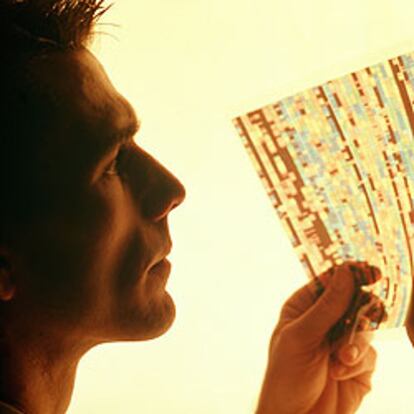From single-cell protozoans to multicellular animals
An evolutionary transition that changed life on earth
Biologists have recently identified some very simple organisms which are the closest living relatives of today's multicellular animals. We did this by sequencing some of the genes shared by both groups - that is, discovering the order in which the genes appear - and then comparing them. This allowed us to examine the evolutionary history and relationship between them, a study known as phylogeny. Thanks to the efforts of several labs the closest single-celled relatives of today's larger animals have been identified. And what are they? They are minute, little-known, single-celled creatures known by such weird names as choanoflagellates, ichthyosporeans, Ministeria and Capsaspora.
Now we have linked today's animals with their tiny relations, a new, bigger goal has been set: the deciphering of the complete genome sequence of these single-celled creatures. Once this is deciphered and compared, it might be possible to identify the genetic 'toolkit' for multicellularity, that is, the basic genes that allow organisms to enjoy a multicellular lifestyle.
To achieve this, an international consortium known as UNICORN was formed. Led by Professor Michael W. Gray at Dalhousie University, Canada, the project is endorsed by the US National Human Genome Research Institute (NHGRI), and includes research groups from the UK, USA, Canada and our group from the University of Barcelona. Our target is to obtain the complete genome sequence of a dozen of the closest extant single-celled relatives of animals. Millions of sequences are being generated, and as the data are analysed, some significant insights are emerging.
Remarkably, many of the genes involved in multicellular functions, such as those concerned with adhesion and communication between cells, are already present in the single-celled animal relatives. For example, our group recently showed that the cell-adhesion machinery mediated by the proteins known as integrins, which were believed to be an animal innovation (and which is absent in plants, fungi and algae), is present in Capsaspora. We do not know what this cell-adhesion machinery is doing in a unicellular organism - after all, there are no other cells to attach to - but this finding means that animal ancestors became multicellular by using much of the gene machinery already present in their genomes, and by adapting their functions to the new multicellular lifestyle. But how did they adapt those ancestral genes into new, more complex, roles? As usual, more work needs to be done, and my team at the University of Barcelona is actively researching in that direction.
To understand what happened 520 million years ago is no easy task, but the prize is worth the effort. As Simon Conway-Morris wrote in Crucible of Creation (Oxford University Press, 2000) '... when animals appeared the world changed, in some ways, for ever'. Our research aims to decipher and understand the genetic mechanisms responsible for that important moment in the history of life, and provide biological insights into the origin of key proteins in animal development. But, most significantly, it will improve our understanding of a fundamental biological question, which itself deserves to be fully answered and understood.
Iñaki Ruiz Trillo, University of Barcelona. www.atomiumculture.eu

Tu suscripción se está usando en otro dispositivo
¿Quieres añadir otro usuario a tu suscripción?
Si continúas leyendo en este dispositivo, no se podrá leer en el otro.
FlechaTu suscripción se está usando en otro dispositivo y solo puedes acceder a EL PAÍS desde un dispositivo a la vez.
Si quieres compartir tu cuenta, cambia tu suscripción a la modalidad Premium, así podrás añadir otro usuario. Cada uno accederá con su propia cuenta de email, lo que os permitirá personalizar vuestra experiencia en EL PAÍS.
¿Tienes una suscripción de empresa? Accede aquí para contratar más cuentas.
En el caso de no saber quién está usando tu cuenta, te recomendamos cambiar tu contraseña aquí.
Si decides continuar compartiendo tu cuenta, este mensaje se mostrará en tu dispositivo y en el de la otra persona que está usando tu cuenta de forma indefinida, afectando a tu experiencia de lectura. Puedes consultar aquí los términos y condiciones de la suscripción digital.
Archivado En
Últimas noticias
La Fiscalía de Ciudad de México confirma que el hombre asesinado en la Zona Rosa era El Panu, jefe de seguridad de Los Chapitos
Navitrans, una cena de navidad para personas LGBT+ en condición de calle y trabajadoras sexuales
Bolsonaro deja la cárcel para operarse de una hernia
Bonoloto: comprobar sorteo del jueves 25 de diciembre
Lo más visto
- La revalorización de las pensiones queda en el aire por la negativa de la derecha a apoyar otras medidas sociales
- Zelenski confirma que cualquier pacto con Rusia deberá ser ratificado en referéndum
- Los ‘whatsapps’ de Mazón a Feijóo del día de la dana: “Un puto desastre va a ser esto presi”
- Víctor Bermúdez, profesor de Filosofía: “Hemos perdido el control del proceso educativo, lo que damos en clase es en gran medida un simulacro”
- El líder groenlandés responde a Trump: “Groenlandia es nuestro país. Nuestras decisiones se toman aquí”




























































